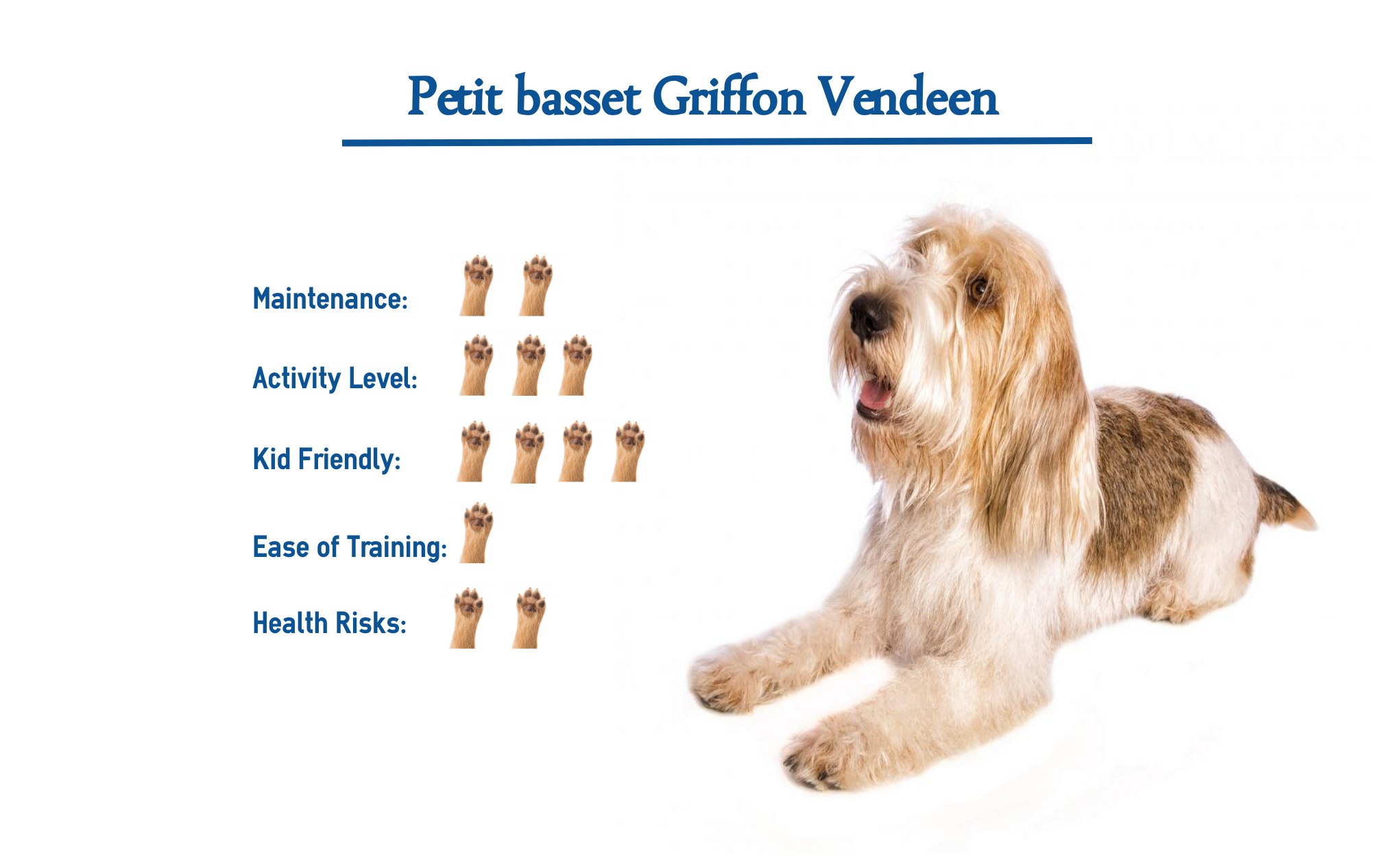Are you looking for a mid-sized dog to join your family? Maybe a dog with a cheerleader personality? Then you’re going to want to consider a Petit Basset Griffon Vendeen. Now there are a lot of good points about this pup, but like with any adoption, you should know all about the breed before committing. Because the last thing that you want to do is run out and adopt one of these cute little guys only to learn a few weeks later that your personalities aren’t a good fit.
Which is why…
In this article, we wanted to take a moment and discuss exactly what it might be like to own a Petit Basset Griffon Vendeen so that if you’re ever allowed to make one of these little guys your own, you’ll know exactly what to do!
So, without further ado, let’s dive right in.
Petit Basset Griffon Vendeen Dog Breed Fast Facts
Country of Origin: France
Original Purpose: Hunting and tracking small game
Height: 12 to 16 inches at the shoulder
Weight: 22 to 45 pounds
Lifespan: 10 to 15 years
Dog Breed Classification: Hound Group
Origin of the Petit Basset Griffon Vendeen Dog Breed
The Petit Basset Griffon Vendeen (known as the PBGV for short) is an ancient breed. This French hound has been in existence for hundreds of years. And back in the day, the land he was initially from was thorny, dry, and rocky. This breed of dog was up for hunting in such an undesirable terrain. Most of the prey in the area were rabbits, small rodents, and some birds.
During this time…
This breed maintained its existence and independence simply because it was a quality animal. Several hundred years ago, folks weren’t all that concerned about “breed standards” and whatnot.
Fortunately…
This began to change over the years, and back in 1901, these little guys “got” their club: The Club du Basset Vendeen. At this time, a man named Paul Dezamy decided to “officially” record the “breed standard” for the Petit Basset Griffon Vendeen when he acted as the club president. Only back then, the Grand Basset Griffon Vendeen and the PBGV were able to be born in the same breed. But this isn’t true now – the two are distinct breeds, each with its breed standard.
Ironically…
Even though these little guys have been around for hundreds of years, it took a while for them to catch on here in the United States finally. It wasn’t until 1984 that the first the Petit Basset Griffon Vendeen Club of America was founded (aka the PBGV Club). And even then, it still took the American Kennel Club (AKC) another seven years to finally get around to “officially” recognizing them breed themselves.
Physical Characteristics
The PBGV looks like a stereotypical Vendeen dog. We can say he’s pretty much a shorter Briquet Griffon Vendeen or Grand Griffon Vendeen. This is a mid-sized dog with short legs. He’s usually white or white and tan medium-length fur and a longer tail. He has a thick and rough overcoat and a faster, softer undercoat. Grooming needs are basic – plan to comb or brush out the knots at least once a week, more if you see fit.
Two other…
Noticeable traits are the dog’s floppy ears and long eyebrows. You may want to give those a trim (the eyebrows, not the ears!) if it appears they keep falling in his eyes, obstructing sight.
Personality and Temperament
This is one of the happiest French Hounds you’ll find. They love to make their owners happy. Additionally, as scent hounds, they’re very curious and love to sniff around for new adventures. Sometimes this can be interpreted as unnecessarily naughty, but he’s just a pup that wants to have fun!
Now…
If you are getting a PBGV, it’s important to remember these dogs need some exercise. They were bred to chase small game-like rabbits and rodents. While you may not want them bringing home prey, you’ll have to find an alternate way to satisfy his hunting instinct. Also, if you get one of these hounds, start the training when he’s a puppy. PBGV puppies that go untrained can be a bit harder to handle (but this is true of all puppies). Eight weeks is an excellent time to start.
Potential Health Concerns
Like all dogs, a PBGV can cause some health problems. However, like all breeders, choosing the right breeder can significantly increase your chances of getting a healthy dog. If you are a kind-hearted soul and want to adopt a rescue PBGV, then know that higher health risks are involved – that’s why he’s a rescue.
Some of the most common health problems are:
- Hip Dysplasia – could need surgery or have problems walking/running that they can live with.
- Hypothyroidism—will likely need medication for the rest of their life to regulate hormones.
- Patellar Luxation—another possible surgical need. It affects walking and running
- Eye problems—could have trouble seeing; sometimes surgery works, sometimes not. It depends on the eyesight problem.
And while…
Many of these conditions may not be life-threatening, but they can become quite expensive, particularly if they become recurring issues. This is why we here at IndulgeYourPet also recommend that any new pet owner take a moment and see what it might cost for you to purchase a pet insurance policy for your new animal.
Now will a pet insurance policy be suitable for everyone?
No, probably not. But until you fully understand what these policies “will” and “won’t” cover and how much these pet insurance policies cost, how will you know if one might be right for you?
For more information on who we feel currently offers the “best” pet insurance policies out there, we would encourage you to check out our Best Pet Insurance Policies article.



